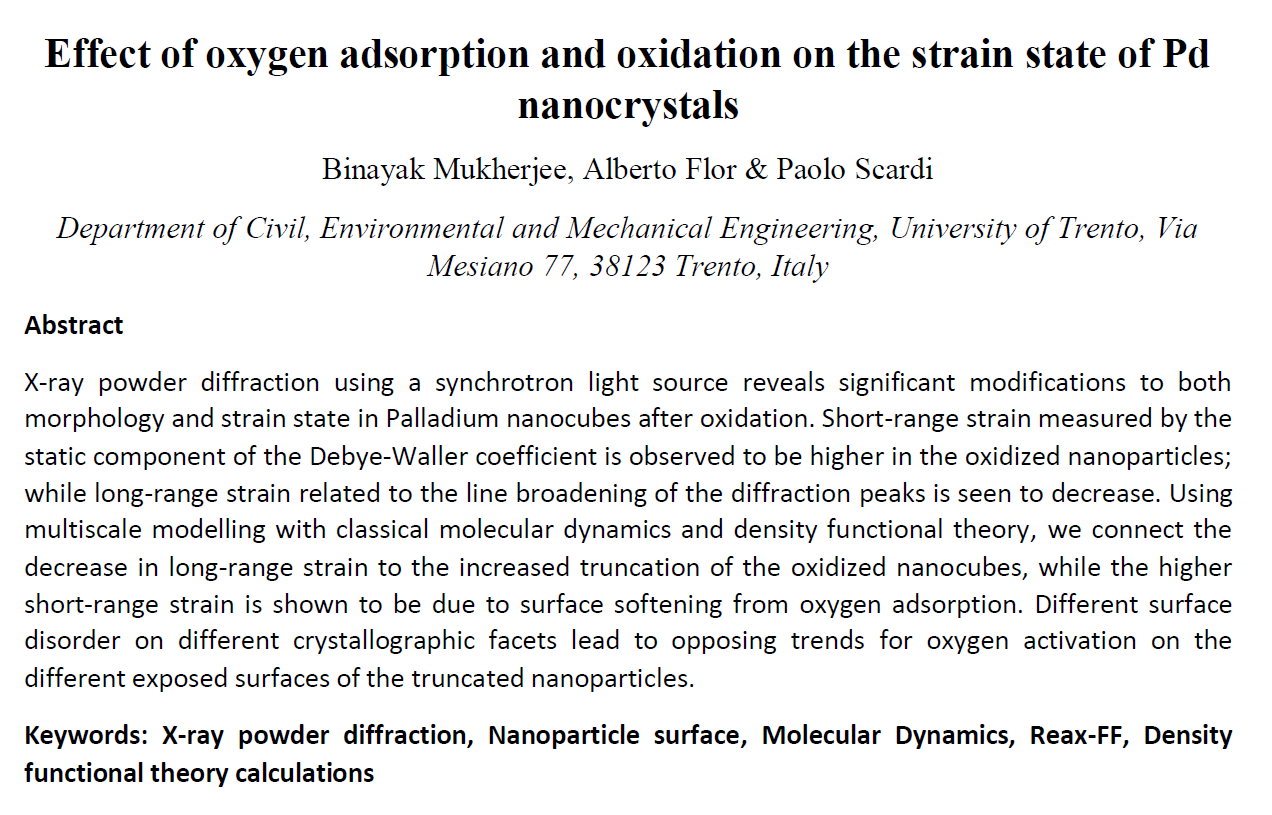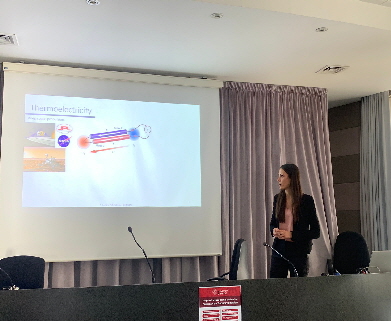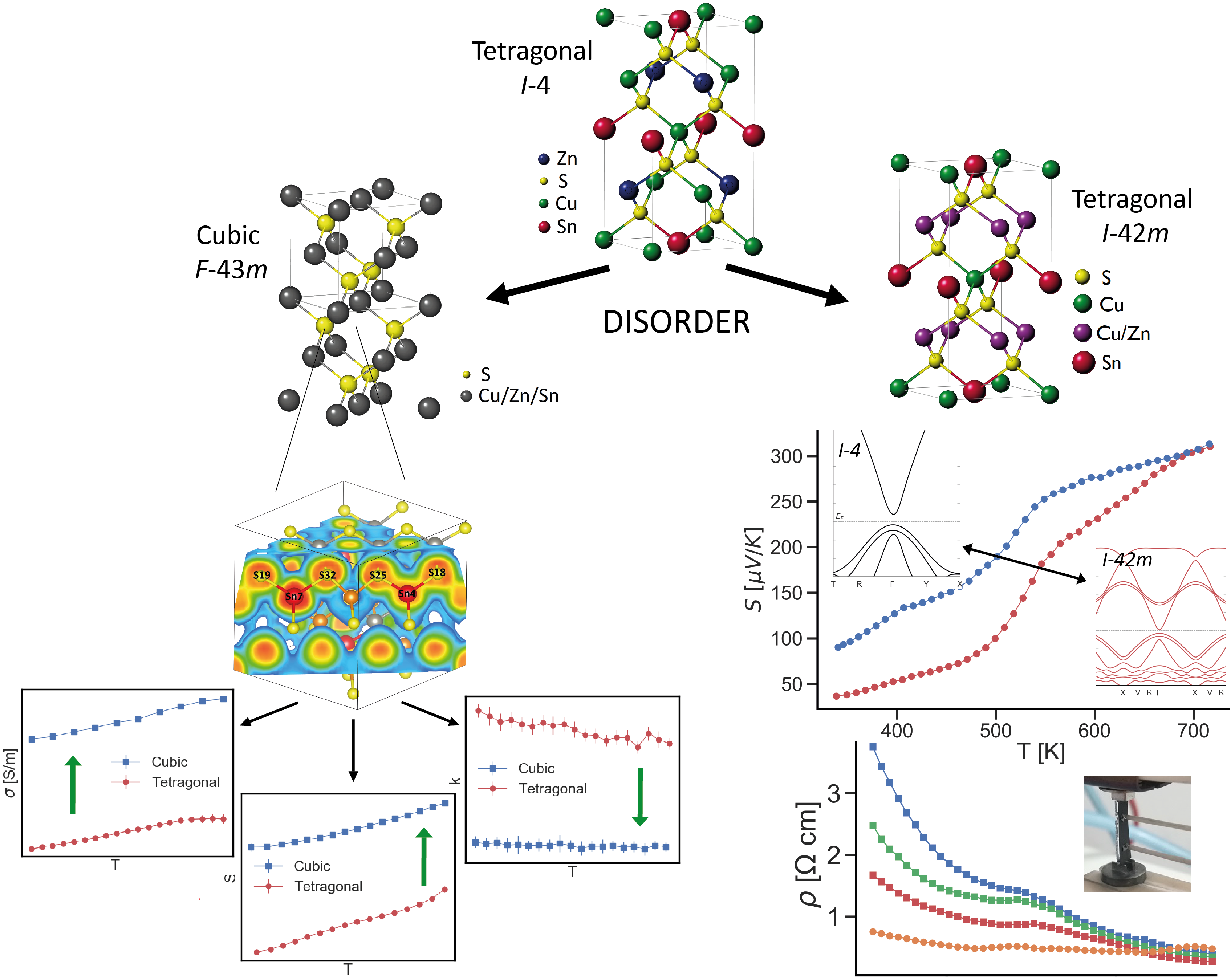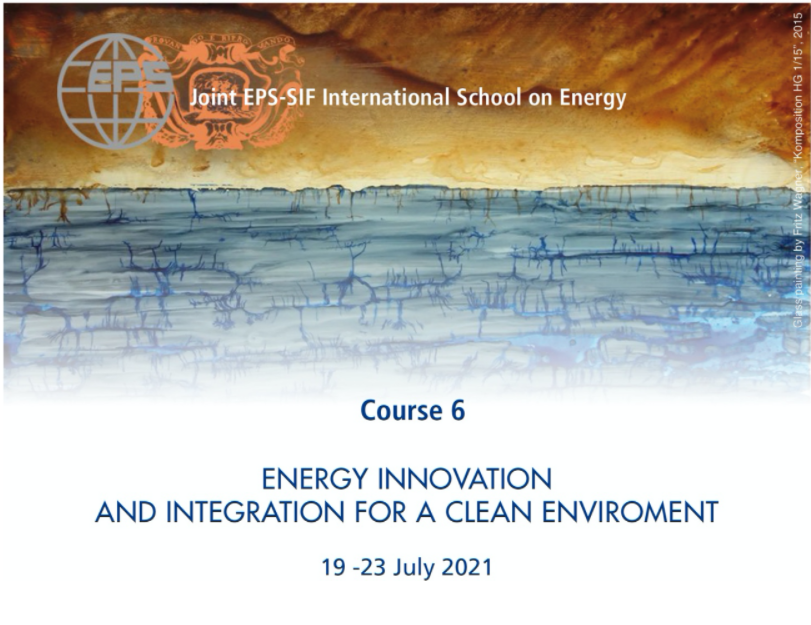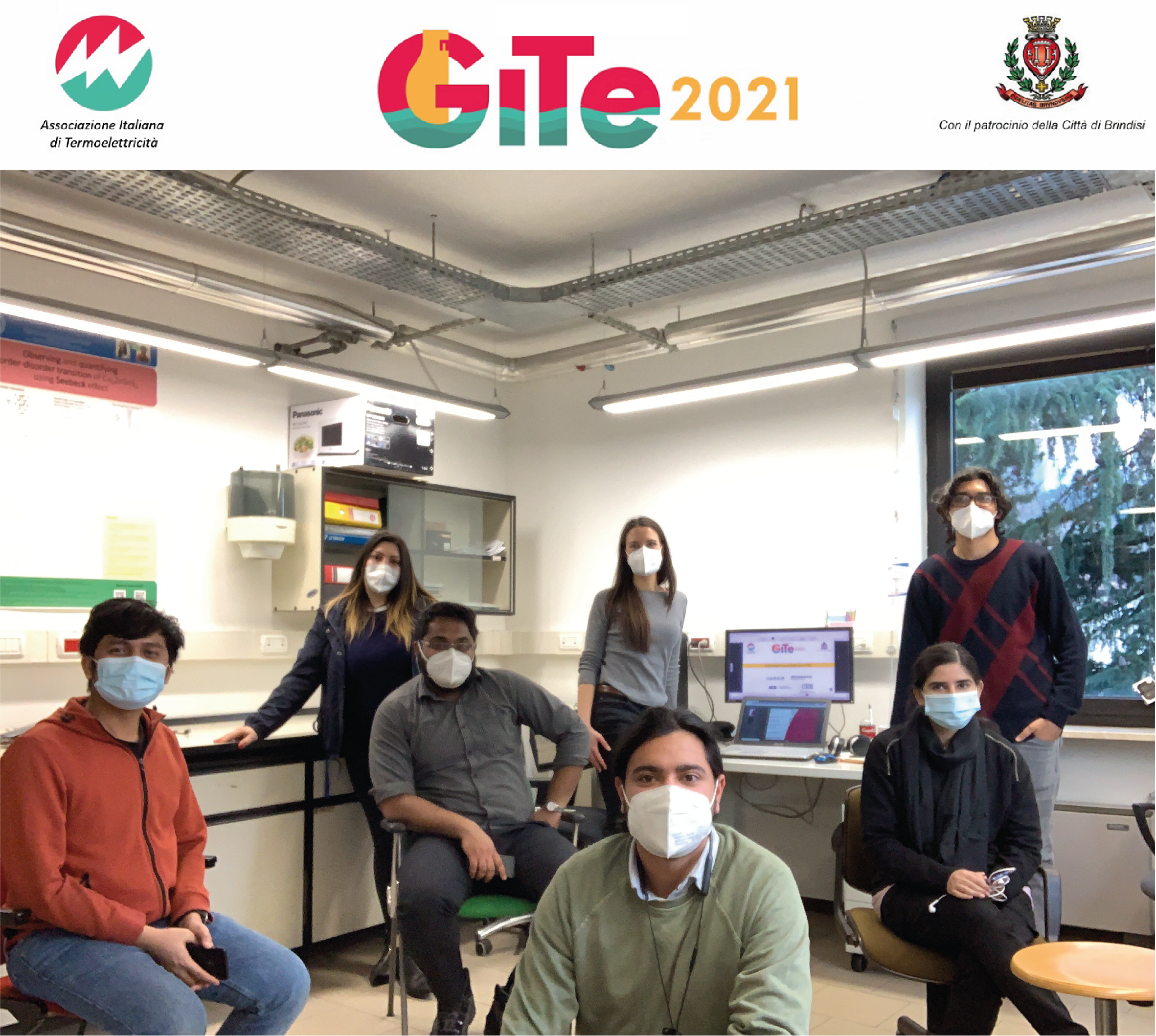
NEWS: 2021 from the team
October 19, 2021
Effects of Grain Size on the Thermoelectric Properties of Cu2SnS3: An Experimental and First-Principles Study
Ketan Lohani, Himanshu Nautiyal, Narges Ataollahi, Krishnendu Maji, Emmanuel Guilmeau, and Paolo Scardi
https://doi.org/10.1021/acsaem.1c02377
© 2021 The Authors. Published by American Chemical Society - Applied Energy Materials
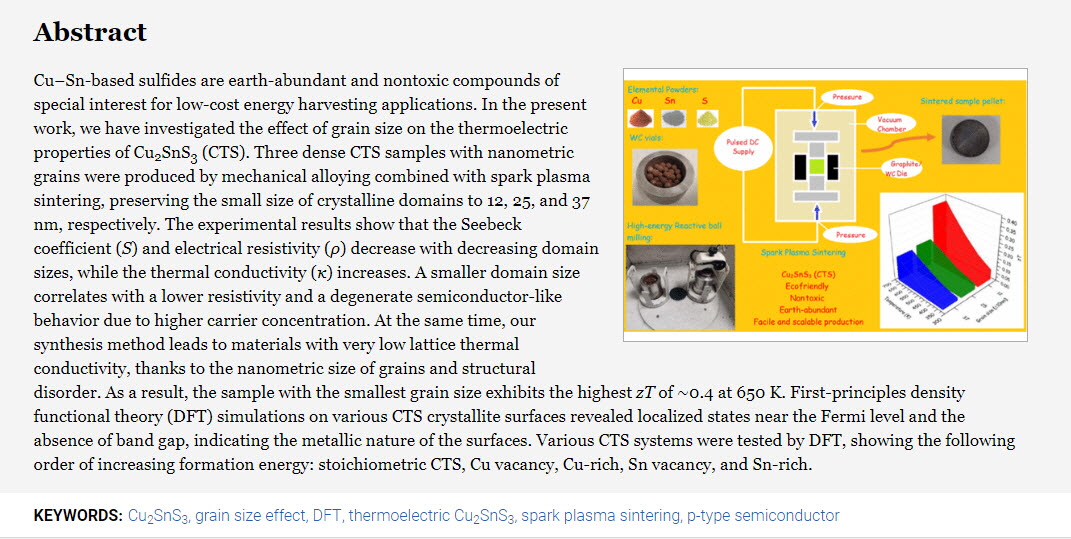
October 27, 2021
We would like to point out the availability of a PhD scholarship in our research team starting from January 2022, funded by the National Operational Programme
(NOP) on Research and Innovation 2014-2020.
The topic of the PhD is "Development of Novel Membranes Fuel Cells: a Green Technology for Power Generation"
Host company: Arco FC
Deadline: 27 October 2021
More detailed information is available on the website:
https://energymaterials.unitn.it//Team/Open-Positions/open-positions.html
https://www.unitn.it/en/nop-call
September 7, 2021 Eleonora Isotta and Ubaidah Syafiq bin Mustaffa PhD Thesis Dissertation
Here's a short report of the Eleonora Isotta Thesis dissertation:
Title: Nanostructured thermoelectric kesterite Cu2ZnSnS4
Report: To support the growing global demand for energy, new sustainable solutions are needed both economically and environmentally. Thermoelectric waste heat recovery
could contribute by increasing industrial process efficiency, as well as powering stand-alone devices, microgenerators, and body appliances.
The structural complexity of quaternary chalcogenides provides an opportunity for engineering defects and disorder, to modify and possibly improve
specific properties. Cu2ZnSnS4 (CZTS, often kesterite), valued for the abundance and non-toxicity of the raw materials, seems suited to explore these
possibilities, as it presents several structural defects and polymorphic phase transformations.
The aim of this doctoral work is to systematically investigate the effects of structural polymorphism, disorder, and defects on the thermoelectric properties of CZTS, with
particular emphasis to their physical origin.
A remarkable case is the order-disorder transition of tetragonal CZTS, which is found responsible for a sharp enhancement in the Seebeck coefficient due to a flattening and
degeneracy of the electronic energy bands. This effect, involving a randomization of Cu and Zn cations in certain crystallographic planes, is verified in bulk and thin film
samples, and applications are proposed to exploit the reversible dependence of electronic properties on disorder. Low-temperature mechanical alloying is instead
discovered stabilizing a novel polymorph of CZTS, which disordered cubic structure is studied in detail, and proposed deriving from sphalerite-ZnS. The total cation
disorder in this compound provides an uncommon occurrence in thermoelectricity: a concurrent optimization of Seebeck coefficient, electrical and thermal conductivity.
These findings, besides providing new and general understanding of CZTS, can cast light on profitable mechanisms to enhance the thermoelectric performance of
semiconducting chalcogenides, as well as delineate alternative and fruitful applications.
Here's a short report of the Ubaidah Syafiq bin Mustaffa Thesis dissertation:
Title: Alternative uses of CZTS thin films for energy harvesting
The search for renewable energy resources and ways to harvest them has become a global mainstream topic among researchers nowadays, with solar cells and thermoelectric generators among the energy harvesting technologies currently being researched in vast. CZTS (Cu2ZnSnS4), a p-type semiconducting material initially researched to replace copper indium gallium selenide (CIGS) as the light absorbing layer in thin film solar cells, was studied in this doctoral work for alternative uses in energy harvesting. This work aims to systemically investigate the prospects of CZTS to be used as hole transport layers and thermoelectric generators.
CZTS thin film was successfully fabricated using a versatile approach involving hot-injection synthesis of CZTS nanoparticles ink followed by spin coating and thermal treatment. Results obtained revealed the possibility to fine control CZTS thin film fabrication based on ink concentration and spin. Besides that, thermal treatment temperature was found to affect the film’s overall properties, where an increase in thermal treatment temperature improved the degree of crystallinity and electrical properties. In addition, a phase change going from less stable cubic and wurtzite structures to a more stable tetragonal structure was also observed. Furthermore, CZTS was found to be a good candidate to replace the commonly used organic hole transport layer in perovskite solar cells, with potentials in improving performance and stability. In addition, CZTS also possessed good transport properties to be a potential p-type material in a thermoelectric generator, with the preliminary performance of fabricated CZTS/AZO thermoelectric generator showing a maximum power output of ~350 nW at ~160 K ΔT.
These findings provide new perspectives for CZTS in energy harvesting applications, despite the struggle in its development as the absorber layer in thin film solar cells. Besides providing a deeper understanding of CZTS and its vast possibilities in energy harvesting applications, promising future research stemming from this work is also limitless, reinventing ways in material studies, in search of alternative applications which may be of benefit.
October 1, 2021 Last publication: Topological Anderson Insulator in Cation-Disordered Cu2ZnSnS4
by Binayak Mukherjee, Eleonora Isotta, Carlo Fanciulli, Narges Ataollahi and Paolo Scardi Materials 2021, 11(10), 2595; https://doi.org/10.3390/nano11102595
Abstract
We present the first candidate for the realization of a disorder-induced Topological Anderson Insulator in a real material system. High-energy reactive mechanical alloying produces a polymorph of Cu2ZnSnS4 with high cation disorder. Density functional theory calculations show an inverted ordering of bands at the Brillouin zone center for this polymorph, which is in contrast to its ordered phase. Adiabatic continuity arguments establish that this disordered Cu2ZnSnS4 can be connected to the closely related Cu2ZnSnSe4, which was previously predicted to be a 3D topological insulator, while band structure calculations with a slab geometry reveal the presence of robust surface states. This evidence makes a strong case in favor of a novel topological phase. As such, the study opens up a window to understanding and potentially exploiting topological behavior in a rich class of easily-synthesized multinary, disordered compounds.
Keywords: quaternary chalcogenides; topological insulators; disordered systems; kesterite; thermoelectrics
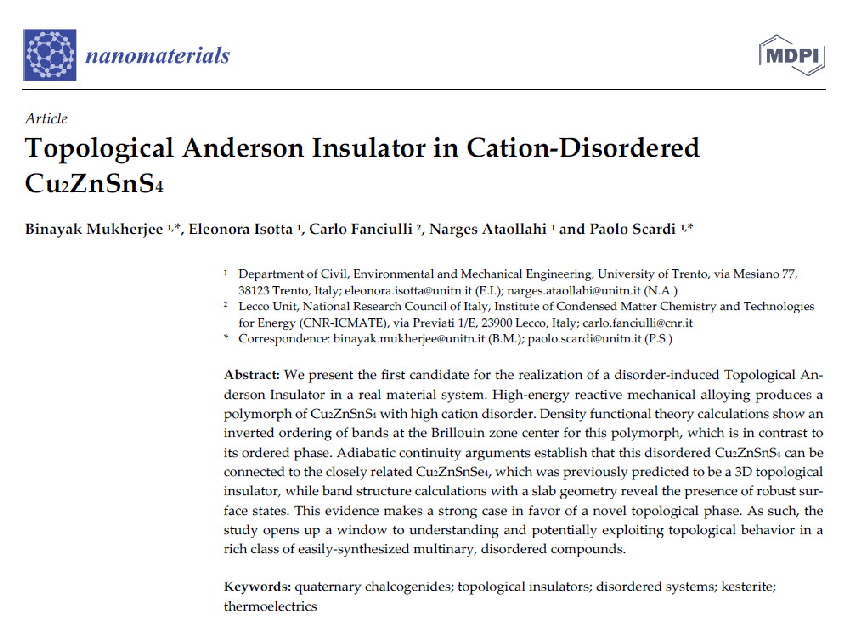
July 20-22, 2021 Virtual Conference on Thermoelectrics: An online event to highlight the work of early-career researchers in the thermoelectrics community
Just concluded the Virtual Conference of Thermoelectrics VCT2021, the International online conference to highlight the work of early-career researchers in the thermoelectrics community, with three oral contributions from the lab.
Tuesday 21st July, session Chalcogenides:
Himanshu Nautiyal, Paolo Scardi, First Principle electronic and phononic calculations of CsPbI3 and CsSnI3
Binayak Mukherjee, "Topological Anderson insulator in cation disordered thermoelectric Cu2ZnSnS4"
Eleonora Isotta, "Disorder-driven polymorphism in Cu2ZnSnX4 (X = S, Se): structural insights and thermoelectric transport properties"
Ketan Lohani, "Effect of polymorphism on the thermoelectric properties of Cu2SnS3 (CTS): An experimental and first principles study "

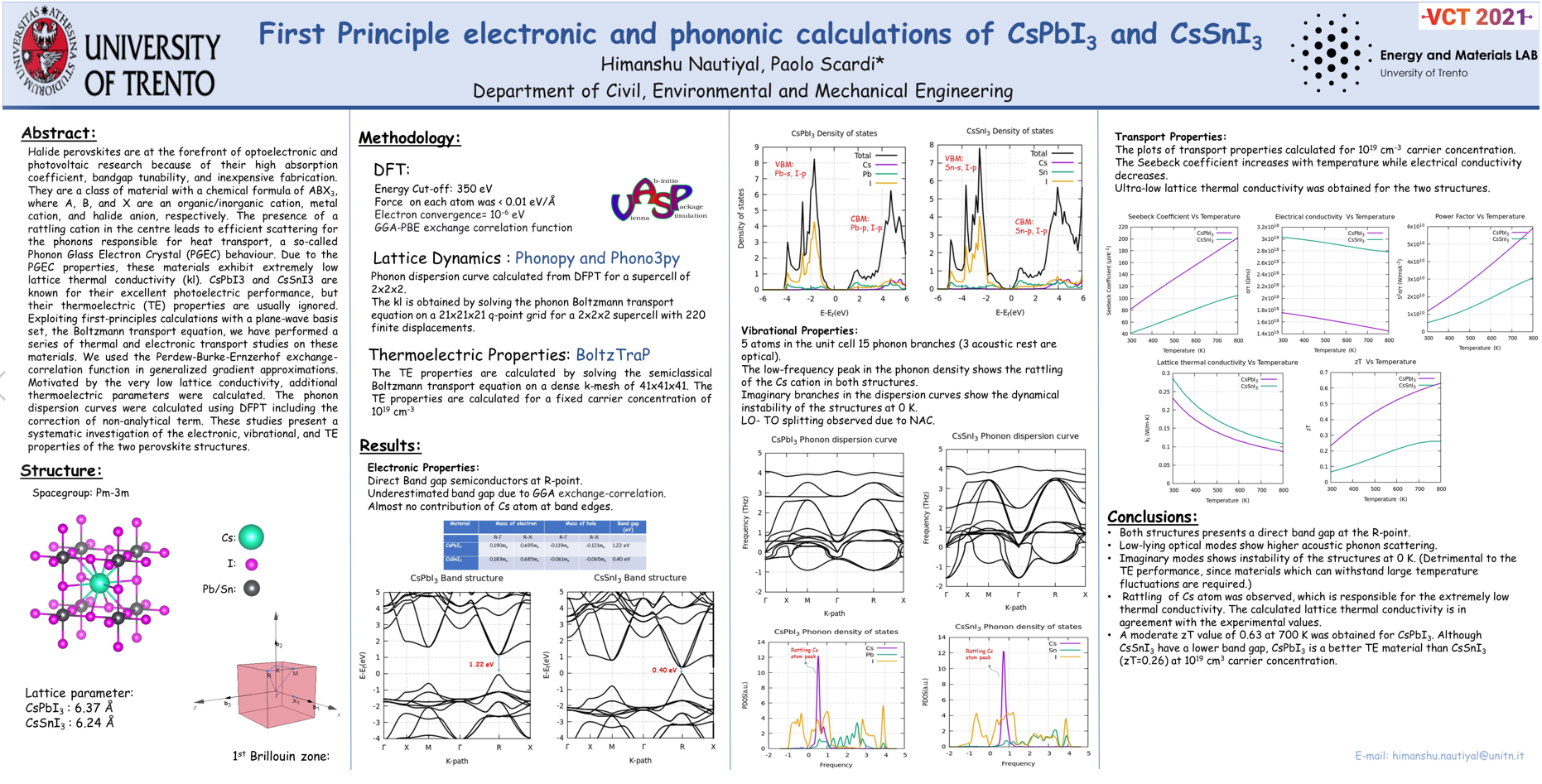
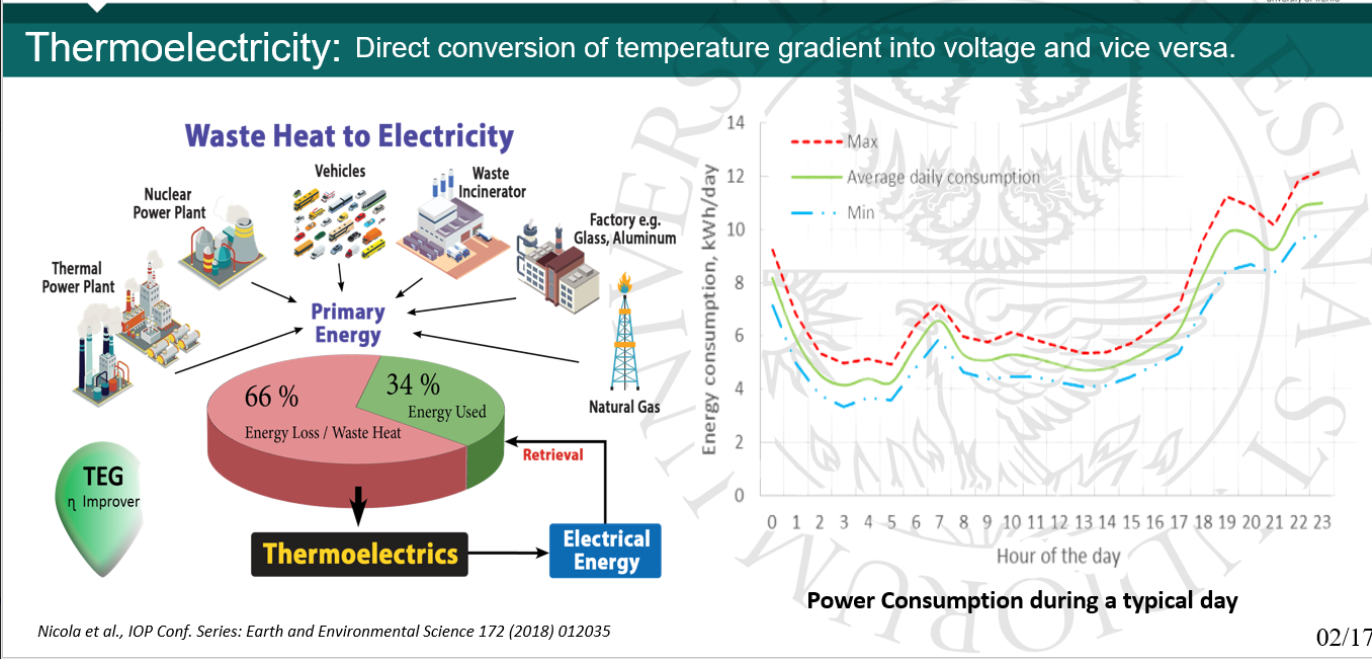
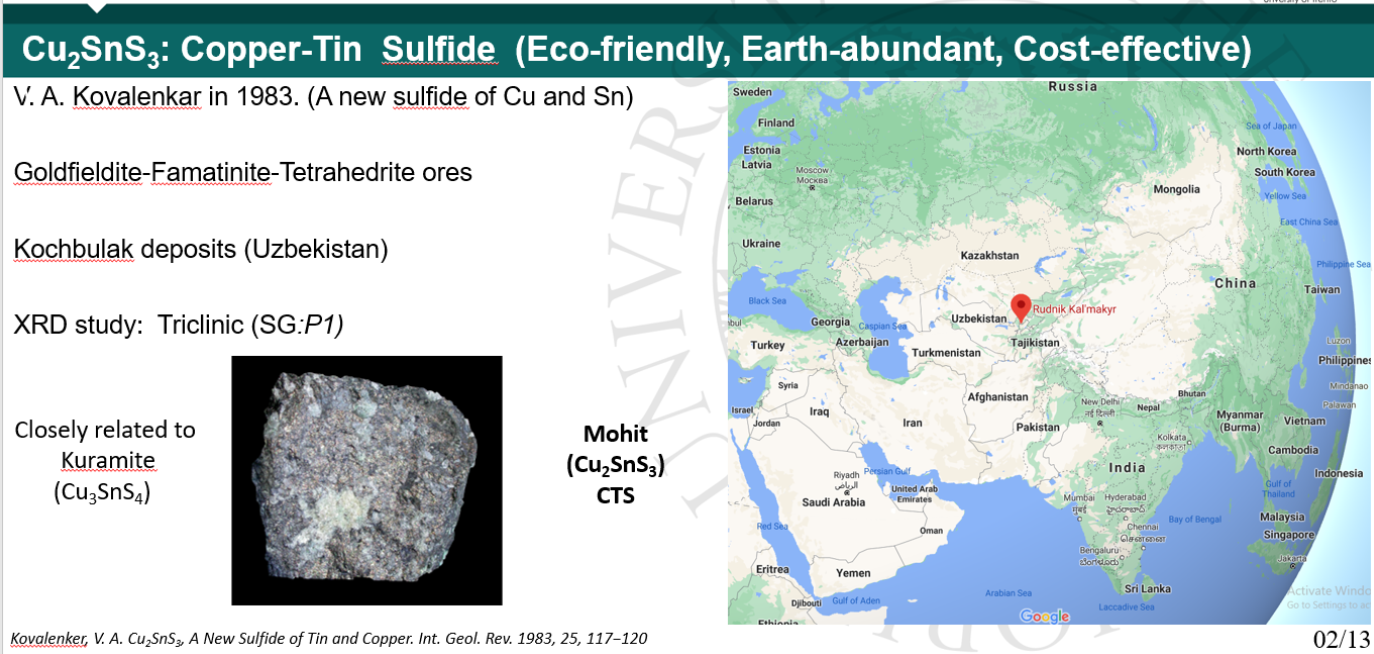
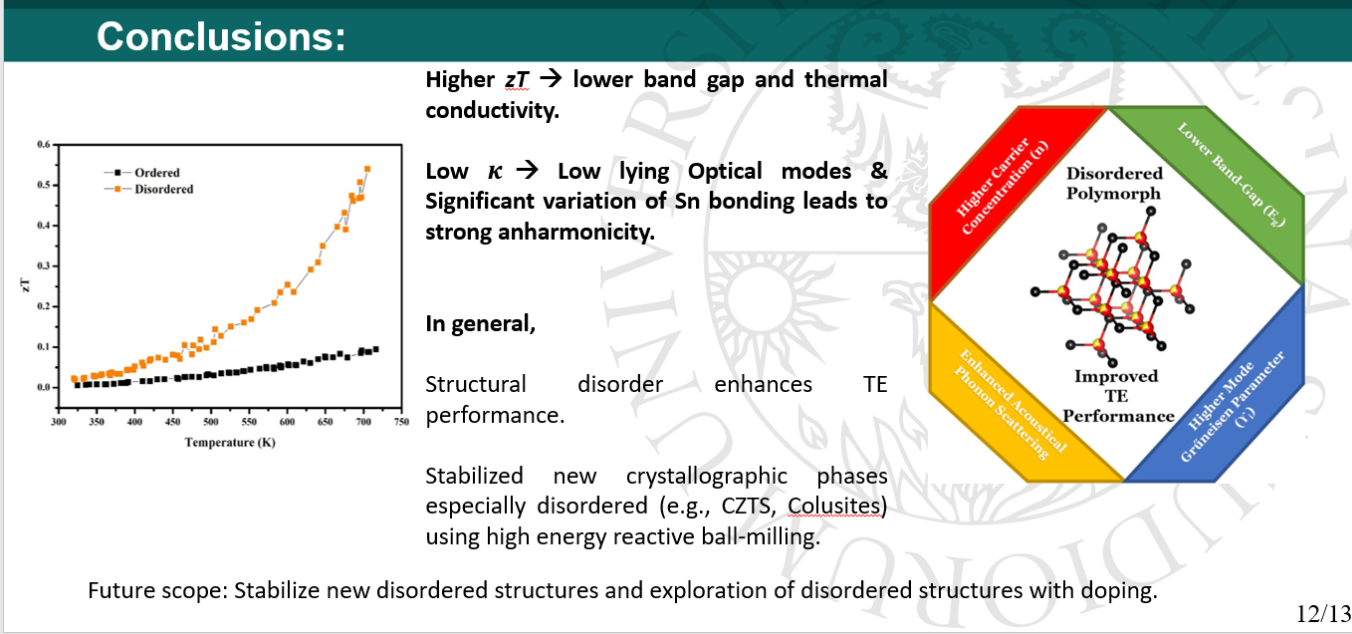
July 19-23, 2021 Joint EPS-SIF International School on Energy 2021 https://www.sif.it/corsi/scuola_energia
Ketan Lohani has presented: Effect of structural disorder on the thermoelectric behavior of Cu2SnS3 (CTS).
TMS 2021 Online, Conference talk from Eleonora Isotta, PhD student of the Energy and materials Lab
March 16 2021, Session "ELECTRONIC MATERIALS Alloys and Compounds for Thermoelectric and Solar Cell Applications IX", with Eleonora Isotta: Effect of structural disorder on the thermoelectric properties of kesterite (Cu2ZnSnS4)
Video: TMS 2021 Online, Conference talk from Eleonora Isotta
For more information see https://www.tms.org/TMS2021
ONLINE EVENT: March 2-4, 2021 Rigaku XRD Forum Power Diffaction

2020 Best Junior Paper AIT Award: Ketan Lohani has been selected as the recipient of the AIT-ACS-Kenosistec 2020 Best Junior Paper Award. Let’s congratulate Ketan for the award of the Italian association of thermoelectricity. A well deserved prize.

Ketan Lohani
February, 2021. Just ended GiTe2021, Giornate sulla Termolettricità, the Italian Conference on Thermoelectricity. Thanks to the Italian Thermoelectric Society for organising these beautiful moments of research sharing and contact even in these difficult times.
AIT: http://ait.icmate.cnr.it/
GiTe2021: https://gite.icmate.cnr.it/evento/2021/
Video: First prototype of ThermoElectric Generator (TEG) at Energy and Materials Laboratory. It actually works! Upon a temperature difference it produces a measurable voltage. Congratulations to Ubaidah Syafiq for building it.
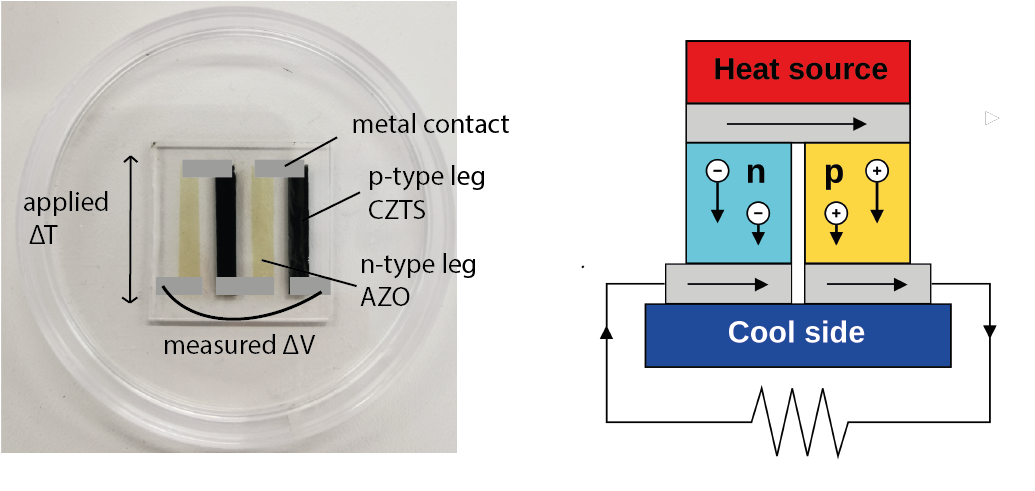
Figure 1. TEG Scheme
Video: Demonstration of I-V analysis on fabricated CZTS/AZO thermoelectric generator (TEG).
Video: The first single Alkaline Anion Exchange Membrane Fuel Cell based on modified Polyketone was assembled in our laboratory. Congratulations to Narges Ataollahi for building it.
Online Conference with two oral presentations from our group
February 17, Session “Calcogenuri”, with Eleonora Isotta (Origin of a simultaneous suppression of thermal conductivity and increase of electrical conductivity and Seebeck coefficient in disordered cubic Cu2ZnSnS4) and Ketan Lohani (Experimental and Ab-initio Study of Cu2SnS3 (CTS) Polymorphs for Thermoelectric Applications).
For more information see https://gite.icmate.cnr.it/evento/2021/
1st March 2021
Effect of oxygen adsorption and oxidation on the strain state of Pd nanocrystals, Binayak Mukherjee, Alberto Flor & Paolo Scardi, Department of Civil, Environmental and Mechanical Engineering , University of Trento http://dx.doi.org/10.1016/j.apsusc.2020.148508
